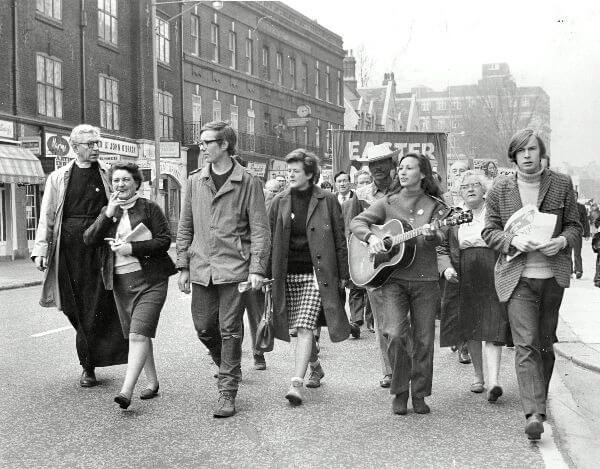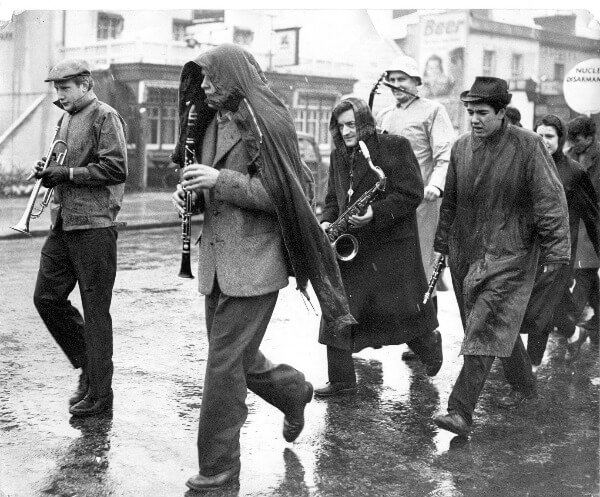 |
Canon Collins, Olive Gibbs and Julie Felix alongside other marchers in 1968
CND in its early years was inextricably linked to the social radicalisation of the time. The early Aldermaston Marches, to the Atomic Weapons Establishment in Berkshire, represented microcosms of the new Britain, articulating both widespread popular dissent and the social rebellion of the youth of the time. In many respects it was through the early mobilisations of the anti-nuclear movement that the radical politics of what were to become the new social movements were first expressed. In his book Bomb Culture, Jeff Nuttall talks of the new youth culture on the marches: ‘Beatniks . . . appeared from nowhere in their grime and tatters, with their slogan-daubed crazy hats and streaming filthy hair, hammering their banjos, strumming aggressively on their guitars, blowing their antiquated cornets and sousaphones, capering out in front of the march, destroying the wooden dignity of . . . the official leaders of the cavalcade. It was this wild public festival spirit that spread the CND symbol through all the jazz clubs and secondary schools in an incredible short time. Protest was associated with festivity. There was a new feeling of licence granted by the obvious humanitarian attitude of the ravers themselves.’
Musicians on the first March in 1958Early sociological studies suggested that many of CND’s early supporters had no formal faith or politics, and were more concerned about ‘working for a more humane society than in finding themselves a good job.’ In particular, surveys found that there was an immediacy to campaigners’ concerns: ‘They believed that the bomb immediately threatened the future of civilisation, that it had to be banned very quickly or Armageddon would come first.’ Simultaneously, however, Cold War anxieties, fear of the bomb and fear of the unknown impact of scientific experimentation were also taking hold on people’s imaginations. Political protest was one manifestation of this, but popular culture also reflected these concerns. Film, again, was a mirror of society’s anxieties. This time Hollywood paved the way, with the developing science fiction genre. Them!, directed by Gordon Douglas in 1954, is about giant radioactive ants on the rampage, the result of an atomic test in New Mexico. Stanley Kramer’s On the Beach, a film adaptation of Nevil Shute’s novel made in 1959, was a story set after a nuclear apocalypse, as a group of people await death from radiation. This film affected audiences strongly and CND decided to conduct a campaign around it. A special leaflet with a tear-off slip for contacting CND was produced to give out to audiences as they left the cinema, and many forms were returned daily. The Lewisham CND group in London leafleted extensively and even held a public meeting on the theme. According to CND’s Annual Report in 1959, there was ‘no doubt that the film is having a big impact.’ Other sci-fi films featured subtexts of anxiety about the spread of communism, such as Invasion of the Body Snatchers, made by Don Siegel in 1956. This was also the time of the McCarthyite witch-hunts of the Left in the US, not only in Hollywood, but in society more widely. Thus the late 1950s were a time of great social and political ferment, of which CND was very much a part. |
|
To celebrate six decades of vibrant and powerful activity, this online exhibition displays photos and memories provided by our members and supporters. They selected the photos that best symbolised a significant memory from the past 60 years. The exhibition shows photos from demonstrations, vigils and blockades; significant sites, like Greenham, Molesworth, as well as photos of artefacts, like favourite badges, banners, and knitting. |
